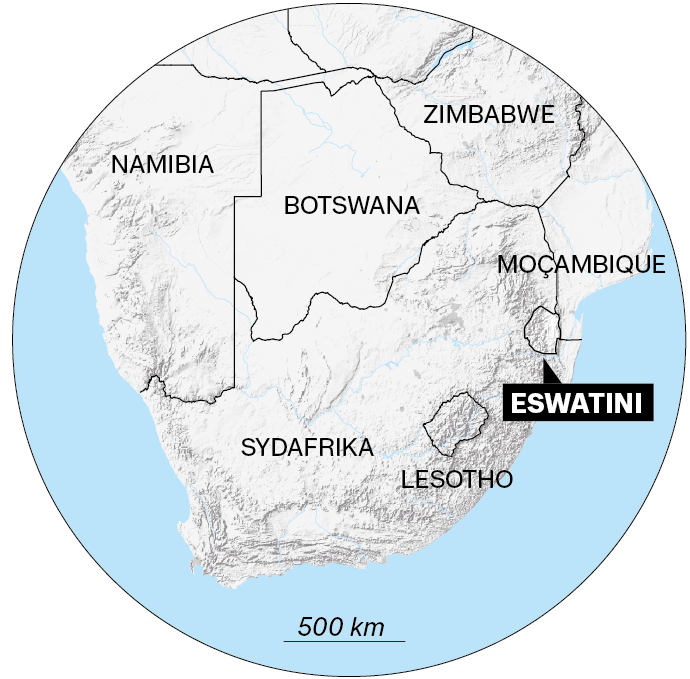Work against HIV is wound up in the world’s most affected land

It was at the age of 24 that Philile Dlamini first thought she had her death sentence. She had sought medical care for throat flux, but tests have shown that she was carrying the HIV virus and had begun to develop AIDS.
But only 21 years later, In January this year, she began planning her own funeral.
– I like to read and follow what is happening, says Dlamini, who today is 45 years old and the mother of four children.
– As soon as I heard about Donald Trump’s decision, I checked that my funeral insurance is valid, she tells DN.
She talks about Trump’s decision to close down the entire aid authority USAID, which has stopped the money flow to the entire HIV control in southern Africa.
Motjane is a small village in the countryside in the small country of Eswatini, which until 2018 was known as Swaziland. Here to the clinic, Philile Dlamini has come every three months to retrieve the brake medication that keeps the disease in check and which allowed her to live a normal life. The other week she was here with a child to be vaccinated, and she then noted that the staff working with the HIV patients were gone.
– I was doubtful that there would be medicines when I came here, says Philile Dlamini.

But the vital pills exist Here – so far. Philile acknowledges them and heads away along the country road, to the place at the creek where she sells candy and chips for children who are on her way home from the nearby school.
It was in the Count’s time that Philile in 2004 was diagnosed. Just a few years earlier, it had really meant a death sentence. From the mid-1980s, the HIV pandemic linked its grip on southern Africa and during the 1990s exploded the spread of infection. At most, 27 percent of Eswatini’s population were infected and an expected average life expectancy of 63 years at the end of the 1980s had after the turn of the millennium collapsed to 42 years in the country. An entire generation had fallen victim to the disease.
– At that time, there was someone who was ill in each family, and they were not only carriers of the virus but had also developed AIDS, says doctor Christopher Makwindi behind his desk in an office building in central Mbabane.
– Those who sought care were often so bad that they could not stand on their legs and entered wheelchairs, he says.
But around the turn of the millennium, a global began Power effort give dividends and the work against HIV would change radically during the 00s. Brake medication had previously cost hundreds of thousands of dollars a year for each patient. Now they began to fall sharply in price after new trade agreements that gave poor countries opportunities to buy cheaper copies of the drugs from India.

In 2003, Pepfar, President George W. Bush’s massive support program against HIV/AIDS, was considered one of the most successful aid projects ever. Over the next 20 years, the US Congress would spend $ 120 billion – $ 1.2 trillion – to fight AIDS in poor countries.
Money flowed into the whole the care chain, in the research and in the procurement of brake medication. In Eswatini, healthcare could be decentralized and brake medication rolled out broadly throughout the country, when they were previously only available in larger hospitals. Previously, every fifth child with HIV positive mother had received the infection at birth. Something that today only affects 1.34 percent of all children born in similar circumstances.
– This is the direct impression that Pepfar has done, says Makwindi.

In recent years, he has been country manager in Eswatini for the Elizabeth Glaser Foundation, which was named by an American AIDS activist who was infected in a blood transfusion in the early 1980s and who later died in AIDS. « EGPAF », as the foundation is shortened, has been responsible for the HIV work in two of Eswatini’s four regions.
The work was focused early on stopping transfers of HIV at birth but grew as more money came from the United States. HIV -infected people, so -called « expert clients », were employed as an adviser for new patients, to work with infection tracking and to remind those who forgot to retrieve their medicine with telephone calls. The test business was expanded. Information campaigns were launched to dramatize the disease. The work has produced results. As the first hard-hit country, Eswatini reached the UN’s goal summarized by the figures « 90-90-90 ».
This means the following:
● Of all those who carry the virus, 90 percent should know their status as HIV positive.
● Of anyone who knows that they are positive, 90 percent should be treated with brake medication.
● Of all treated with brake medication, 90 percent should regularly receive medication so that they push the virus down to such a low level that they are not contagious.
Eswatini surpassed the goals, which lowered the spread of infection by 44 percent and mortality by 56 percent in just six years. The pandemic had posed difficulties, but still reached « 95-95-95 » and now they were aimed at the final goal: that the epidemic would be completely under control. Responsibility for the work had gradually been transferred to the government in the country.
Then came the email from Washington. In the middle of the night at the end of January, Christopher Makwindi happened to check his phone and was then told from the US that all work would cease.
– Since then we have gone through all the stages of shock. From denial, to negotiation and then acceptance. Even if you hope somewhere we will be able to resume the business.
When DN comes to visit stands The office chairs stacked against the walls, all furniture is labeled with price tags for them to be sold. In the garage are about 20 four-wheel-drive cars used by the staff. Now everything should be reed. And all staff are dismissed. Because after Donald Trump has basically discontinued the entire US Aid Authority USAID, the money has stopped coming. The Pepfar money is under Congress’s control but cannot be forwarded without USAID.
Precisely the procurement of brake medication is today the government’s responsibility, but the money still comes from USAID and government representatives tell DN that they do not know what the financing will look like in the future.
There is no lighting in sight, after the Trump administration announced that it is planning to close almost all embassies in Africa.
Makwindi is convinced that people will start dying again in the disease, even if it is not visible directly.
– Of course, we hope that someone else wants to enter the void. Anyone who does it will be able to sunbathe in the brilliance if we get the disease completely under control. Maybe it attracts other donors, he says.
If it doesn’t happen, Eswatini stands facing a potential disaster. Since so many have survived with the disease, still carry just under 25 percent of the entire population of the virus. At present, these people have so low virus levels that they are not contagious.
– But if you do not take the medication, the amount of virus rises in the body, which makes people contagious again, says nurse Phumaphi Dlamini.

We are back in Motjane a few days later, a cloudy Wednesday morning in early April. Phumaphi Dlamini not only worries about the spread of infection, but also what will happen if they infected on their own start to take their daily tablets less often, in the event of an immediate lack of medicine.
– If people take lower doses than required, the risk increases greatly for the virus to develop resistance and then we lose the latest generation of brake medication, she says.
Each month the clinic receives Around 800 patients who pick up their medication. One of these is Thuli Gumetze who with its 67 years is one of the oldest survivors. She has followed the HIV pandemic progress in Eswatini from the first case showing up in the 1980s, when she was 28 years old.

-I remember how it was talked about in the 1990s about how everyone would test. In the late 1990s my husband died in HIV but I managed.
She takes up her black book Where every pick -up of medicine is documented since she herself was forced to take the medication.

– Here I see that it was in December 2012 that I first came here, and it was shortly after I tested positively, she says.
How do you think about all the decisions made lately, in the United States?
– If there is no medicine, I wonder if we will live or die. It is our lives that are at stake, she says.
– So it’s painful to hear these news. What will happen to us?
Read more
The aid sinks after the USAID stop: « Children will die »
Swedish aid money stuck in the United States: « Get no answers »














